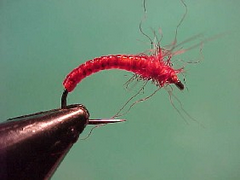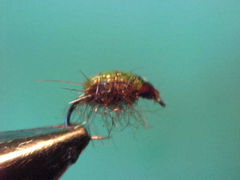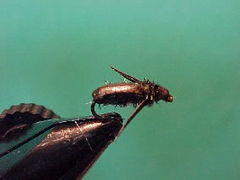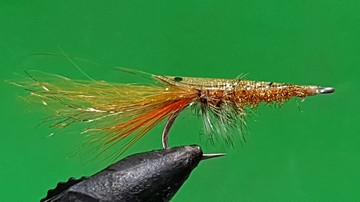My ‘trout’ river wet fly box
{{start}}
River trout fishing can be both challenging and fun. One element that can add to the fun is whilst having the right flies, don’t carry so many that your spoilt for choice or that the number of fly boxes that you carry is becoming to much to lug around. The “wets” that I carry when river fishing are all in this one fly box. This included both bead head and non bead head nymphs and spiders as well as one row of small woolly buggers. If you carry this fly box and my dry fly box you will have flies available that can be successfully applied to the vast majority of ‘trout’ rivers and streams in Australia and New Zealand.
{{end}}

{{+1}}Jelly worm{{-1}}
{{start}}
This fly is a good represent of chironomids in their "blood worm" stage and it works well as an anchor fly in a team of two or three chironomids particularly when fished static early in the hatch.{{end}}

{{+1}}Snail – Chatto’s version{{-1}}
{{start}}
Snails are a food source for trout throughout the year. Having said that they are often overlooked by fly fishers. In colours imitating the naturals in the area to be fished they can be slowly twitched along the bottom or around the weed beds with great results. They are also a good ambush fly for trout foraging the margins. My standard choice of colours is a mottled brown and dark olive.{{end}}

{{+1}}Corixia / back swimmer{{-1}}
{{start}}
Given the similarity of form and function both of these aquatic bugs can be represented by the following fly. This fly is best fished on a floating line that has been greased to within a meter of the fly or under a dry fly. It generally works well just sinking in the water column or moving naturally with the water current. If unnoticed try a couple of short figure of eight strips punctuated by a long pause to represent the natural swimming action of both bugs or a gentle lift to mimic "the natural" rising to the surface to breath.{{end}}

{{+1}}PET shell prawn{{-1}}
{{start}}
Prawns and shrimp are crustaceans, of the family Isopod, and are endemic to our Australian estuary waters. They are toward the top of the food chain for a lot of coastal species of fish including bream, flathead and whiting.{{end}}













